This is part of my history and guide to my adopted home - Terre Haute, Indiana.
Introduction
When I first moved here in October, 2001, people delighted in telling me that Terre Haute was once known as "Sin City" because of the gambling, prostitution, political corruption and labour problems that once went on here.
Most references to Terre Haute as being called "Sin City" refer to two printed articles, one was in Time Magazine and the other in a magazine called "Stag". None of the places referencing these articles give any quotes from them or give any details such as issue number or date of publication; these include Urban Dictionary. There are others, but these but they seem to be quoting from the Urban Dictionary.
I think I've tracked down both articles and neither mention "Sin City" at all. The article in Stag is entitled "Nighttime Girls of Terre Haute" by Stephen Hull and it appeared in the November 1955, Volume 6, No. 11 issue. The magazine appeared to have to catered to a male audience and that particular issue also contained articles entitled "She was Loaded to Blow", "Even the Flesh Burned". "I Rode the Giant Whirlpool", "I Sucked in the Sea", "World of Brothels" and "Why I Shot Joan Tyler", which should give the general idea of what sort of level this magazine was.

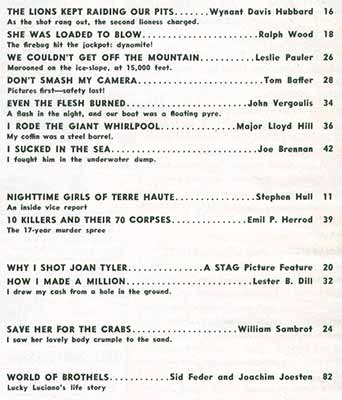
Stag, November 1955 issue, cover and index page
The other article, I believe, was the one in Time Magazine entitled "Indiana: Open House in Terre Haute" which appeared in the February 21st, 1969 issue.
There were several other articles published in a similar vein such as "Indiana's Delinquent City" in the Saturday Evening Post of February 11th , 1961; "The Teenage Torturers of Terre Haute" in True Danger of February 1963; "Our Brothels Stay, Says Mayor 'There is Virtue in Vice'" in Truth! of August 1969 and "Legendary Madame Brown" in the Terre Haute Spectator of June 16th, 1979.
Platted in 1816, Terre Haute started life as a port on the Wabash River and developed into an agricultural and pork packing center. Pork packing was started in Terre Haute by Benjamin Gilman in 1824, and was to be one of the principal enterprises in the city for over 100 years. With development of the National Road (1835), Wabash and Erie Canal (1849), and railways (1852) came prosperity and the city quickly grew and by 1870 was something of a boomtown. By then the major industries were coal mining, iron and steel mills and hominy production alongside glass making, distilleries and breweries. In 1870, Vigo County ranked third in the state in coal mining and fifth in manufacturing. Employment was high, the wages were good and soon there were people who were only too happy to entertain the people and separate them from their money and the gambling houses and brothels started appearing. These probably weren't the first, as both practices were probably around since the early days of the town, but they certainly became more noticeable, and some even attracted the attention of the national press. For the amount of vice and corruption that was carried on here one thing that Terre Haute stayed clear of was the organized crime that plagued larger cities.
Mayor Bidaman Impeached
Even as far back as 1906, people were trying to keep some sort of control over Terre Haute's red light district. Edwin J. Bidaman, an ex-police force officer, was elected mayor in 1904. At first he was praised in his efforts to control the red light district, but his softly, softly approach annoyed some members of the city council, even though the defeated mayor, Henry C. Steeg had done next to nothing about the gambling, prostitution and other vices in Terre Haute.
Steeg had been supported, some say controlled, by Democratic leader John E. Lamb. A former congressman and an outstanding trial lawyer, Lamb represented virtually every privately owned municipal utility. Opponents accused him of negotiating favorable deals with the city on behalf of his clients at the taxpayers' expense. Whereas, even his political opponents said that Bidaman was an honest man.
At the time, the city ordnances stated that saloons must be closed at 11 p.m. during the week and all day on Sunday but almost all stayed open nearly all night and opened on Sundays. Bidaman had eliminated the use of slot machines but permitted gambling upstairs in two-story businesses. It seems he couldn't please anybody. Saloonkeepers were unhappy, but so were many ministers and church groups.
Bidaman was impeached by a 6-3 vote of the City Council on June 27th, 1906. Bidaman refused to leave office and secured a temporary restraining order. On July 6th, at 4:15 p.m., Indiana Appellate Court Judge Wood D. Robinson, serving as special judge, dissolved the restraining order and Bidaman was coerced to abandon his challenge. City Controller Frank M. Buckingham succeeded him as mayor the next day. This wasn't the first attempt to get rid of Bidaman. The City Council had tried to impeach him around six months earlier but couldn't get the 6 votes necessary - they only managed to get 5.
Bidaman was perhaps unfairly impeached, he was never accused of anything unlawful, but although he was making some sort of headway, he wasn't clearing the red light district as fast as some on the city council would have liked. Don M. Nixon, editor of the Saturday Spectator wrote of Bidaman, "The people love Edwin J. Bidaman for the enemies he has made. Few men could be more fortunate."
At a meeting on August 7th, 1906, the Board of Public Safety issued new rules concerning the area trying to move the more lurid west of Third Street. The order directed "all immoral characters" to remove themselves from Fourth Street and from Eagle Street, between Third and Fourth streets. Prostitutes in brothels on those streets remaining after August 20th, 1906, were subject to arrest and fine. Earlier attempts at moving these places met with protests that they would suffer undue hardship and so they stayed. This attempt also failed and the brothels were still there 60 years later.
1914 Election Rigging
Charles Monroe Fortune was elected city judge of Terre Haute in 1905. In 1908 he resigned this post after being elected Circuit Judge. In January 1914, he brought to light the widespread election rigging of which Terre Haute was the centre. Taking office on January 5th, 1914, just 12 days later, on January 17th, Mayor Donn M. Roberts was arrested on charges concerning bribery and fraud with an $8,000 bond. Roberts, the sheriff and circuit judge, Eli Redman, were among the 132 people indicted. Eventually, over 100 people would be found guilty of their part in the scheme. One of the people making the arrests were United States Marshal Frank Storen from Indianapolis.
The November 1913 elections in Terre Haute was something that is now more likely seen in the news about some third world country or somewhere run by a despotic dictator, but which was apparently pretty common in United States elections of the time. There were slush funds to buy votes, false registrations and if those methods didn't work, gangs of thugs to threaten people at the election booths.
Up until then there was little or no no federal oversight of state elections and what prosecutions there were, were always blocked. Before the trial started several southern Democrats, including Kentucky's Senator Ollie James and Congressman A. O. Stanley tried to stop the prosecutions saying that the federal courts had no jurisdiction over state elections and that the Supreme Court were assaulting the rights of sovereign states. Roberts wrote to Stanley saying that with the actions of the Supreme Court "the white man had just as well move out of the South and turn the offices over to the Negroes." The Supreme Court's argument, delivered by Justice Oliver Wendell Holmes, was that "We regard it equally unquestionable that the right to have one's vote counted is as open to protection by Congress as the right to put a ballot in the box."
The trials started in March, 1914, in Indianapolis and 80 of the accused pled guilty. The trial was attended by women of the Mississippi Valley Suffrage Conference who wanted to see how elections were run by the men who also denied them the right to vote. Women finally got the vote with the passing of the Nineteenth Amendment on August 18th, 1920.
One city employee testified that at the instigation of Edward Holler, the police chief, he wrote out fictitious registration cards and that he had simply made up the names on the cards as well as given them an age and place of birth. At his testimony, Holler said that at Roberts suggestion he had 2,500 of these registration cards made. The cards were given to "floaters" who were paid $5 to vote. One of these "floaters", Cortlandt Rector, testified that he'd been paid $8 to vote 10 times. Another testified that he'd voted a total of 22 times during the election.
Another employee testified that when he reported to Roberts that one precinct proved troublesome because they could not be bought or intimidated, Roberts replied that he should "get something to put into their pockets and have them arrested for carrying concealed weapons." An election and registration inspector said that he'd given out 500 tokens worth $1 each redeemable in local saloons. Roberts also organized the collection of a $6,000 "slush fund" from saloons and gambling houses promising them they'd be put out of business if they didn't pay.
Those on trial included mayor Donn M. Roberts; circuit judge Eli H. Redman; controller Elmer E. Talbott; sheriff Dennis Shea; county sealer of weights and measures Maurice Walsh; president of the board of public works Harry S. Montgomery; city inspector of weights and measures John M. Masselink; city judge Thomas B. Smith; board of public works member George Ehrenhardt; Vigo county Democratic party secretary Edward R. Driscoll; street commissioner Joseph O'Mara; undertaker and Progressive party election official Arthur Gillis.
In April 1915, Roberts was sent to Fort Leavenworth federal prison, Kansas, for six years and fined $2,000 by Judge A. B. Anderson who said he was the "arch conspirator". The circuit judge Eli H. Redman and the sheriff were imprisoned for 5 years and fined $1,000 each. Redman died whilst imprisoned at Fort Leavenworth. It took an entire railroad car to transport all the prisoners down to Kansas to start their prison terms. An appellate judge later said Roberts' crime was "worse than dynamite; that it amounted to treason." It wasn't the end of Roberts political career and he came close to becoming mayor of Terre Haute again in the 1921 election, losing to Republican Ora D. Davis by only 552 votes.
One of the defense witnesses, William Davern, a clerk with the Terre Haute Brewing Company was caught lying on oath and imprisoned for perjury.
The New York Times wrote that "The misfortune of Mayor Roberts and his accomplices and henchmen was in not noticing that the political fashions, like others, change once in a while, and what is safe and even commendable one year may be dangerous and reprehensible the next." Which is pretty damning of the whole election process at the time.
Madame Edith Brown
In 1916, there were reportedly 900 prostitutes and 400 madams in Terre Haute in 1916. For nearly forty years, between 1901 and 1942, one of the best known Madams in Terre Haute was Edith Brown. Born on May 10th, 1874, she left her parent's farm, located near Paris, Illinois in 1891 aged 17. She arrived in Terre Haute and became a domestic maid. In 1901, when she was 27, she became he madam in a brothel located at 213 Mulberry Street. Five years later, in 1906, she kept a brothel at 318 Eagle Street. A law was enacted that no brothels were allowed east of Third Street and so, on December 14th, 1915, she bought a 16 room, 2-storey yellow brick house at 206 North Second Street.

Edith Brown ~ taken around 1900
Image from Legendary Madame Brown - Spectator (Terre Haute), June 16th, 1979 edition
In 1918, this house opened as a brothel with the name of the Circle R Hotel having been sumptuously redecorated with oriental rugs and the finest furniture, china, silver, glass and mirrors, it even boasted a Tiffany glass chandelier. The house had a music room, complete with grand piano, Madam's sitting room, another sitting room, living room, dining room and a barroom, with a bar that had come from Chauncey Rose's Prairie House hotel, which in 1855 had become Terre Haute House. The outside of the house was also striking with a low wrought-iron fence, a Tiffany glass canopy over the front entrance, garden figures and flowers and shrubs laid out in a formal garden.
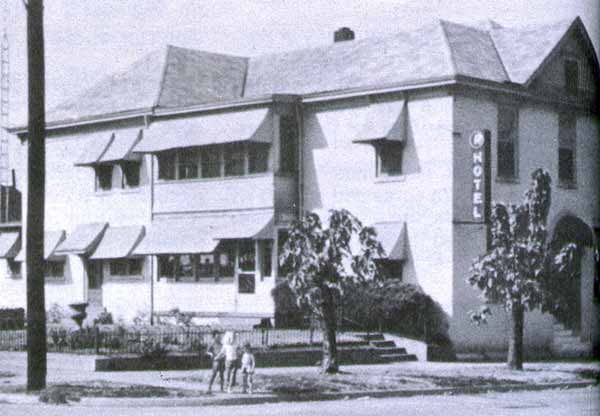
Edith Brown's house at 206 North Second Street
Image from Legendary Madame Brown - Spectator (Terre Haute), June 16th, 1979 edition
As well as the first radio in Terre Haute, Edith Brown also had the first electric car as well as a Cadillac limousine. Her driver was Homer Budd for many years and later, "Red" Ferry. During prohibition (1920 to 1933) Edith used the limousine to run bootleg liquor from Kentucky - who's suspect such a respectable looking lady in such a fine car?
A visitor to the house from those days remembers that...
It was a very dignified place - not bawdy. Everything was formal and the girls paraded in beautiful evening gowns. The house was attractively in a very formal, controlled setting and meticulously clean. Everything was orderly. It was a $5 house when others were $1. Drinks were $1 apiece and that was high in those days. On some Saturday nights, the house was formal. Men had to wear tuxedos and the girls were in evening gowns. Dinner and champagne were served, at a beautifully appointed table, and the cost was $25.
In the early years Edith had a financial benefactor, or maybe several. The house had been furnished with the help of a prominent local furniture store owner. In 1927, she married George Edward Gosnell in Hot Springs, Arkansas. "Eddie" was the owner of a roadhouse and then the private Spring Brook Rod and Gun Club. The two lived more or less separate lives, Eddie in his own house near his club and Edith in the house in North Second Street with her secretary and companion Edith "Jean" Bialorucki who was a widow from Toledo.
Edith gave generously to the Terre Haute Boys Club which was located at 220 North Third Street and during the depression years which started with the stock market crash of October 29th 1929, but with effects lasting until the late 1930's and early 1940's.
Brown continued to run her brothel until 1942. She turned the North Second house into apartments and continued to live there. The tide was changing for the brothels gambling rooms and bars by then anyway. Helen Bergune who represented the Federal Government was already talking to local businesses about ways to put them out of business, but it wasn't until redevelopment in the 1970's that Terre Haute finally lost it's Red Light district.
Edith eventually bought a house in Sarasota, Florida. "Eddie" joined her for the winters. Edith died in Sarasota on October 31st, 1956 aged 82. She left $5,000 to the Terre Haute Boys Club. Her famous brothel at 206 North Second Street was demolished in 1970 by the Department of Redevelopment.
After the boom-times of the 1880's, Terre Haute began a slow decline in the 1920's. There were repeated floods and a succession of bitter labor disputes, including a 1935 general strike. The mines lost money and the rail yards sharply diminished. Prohibition killed off the breweries and glass making in the city sharply declined as a result. The city would still draw visitors to the city though, including infamous gangster Al Capone when he wanted to get away from Chicago. Two of Capone's favourite sayings were "I am just a businessman, giving the people what they want" and "All I do is satisfy a public demand", things that more than one business owner in Terre Haute at the time would agree with.
Labour Problems
Terre Haute had a reputation of being a bad labor town since the 1890's. A street car strike in 1914 meant that a federal judge Francis E. Baker had to issue an injunction against the Street Car Men's Union of Terre Haute to stop them interfering with the street cars belonging to the Terre Haute, Indianapolis and Eastern Traction Company in any way on March 17th, 1914.
Pro-labor federal legislation in the 1930s, such as the Norris - Laguardia Act in 1932, National Labor Relations Act in 1935 and the Fair Labor Standards Act in 1938, bolstered unionization even more. Sporadic strikes included three packing plant walkouts that caused livestock markets to close and the city's meat supplies to dwindle. At the Columbian Enameling and Stamping Company plant, management's refusal to arbitrate with the new Federal Labor Union #19694 on the matter of a closed shop precipitated a strike on March 23rd, 1935.
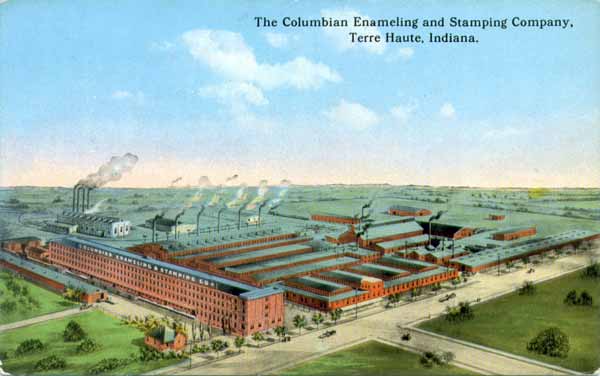
Columbian Enameling and Stamping Company, Terre Haute, Ind.
After four months of impasse and the introduction of 58 armed men from Chicago to "guard" the plant, the city's unions announced a "labor holiday" for July 22nd, 1935. The general strike, just the third in United States history, involved around 22,000 people throughout the city and shut down all business except for critical services. Governor Paul V. McNutt declared martial law and sent 1,500 National Guardsmen to the city. After two days of some violence and 185 arrests and with the troops firing tear gas bombs from 26.5mm Manville guns and using rifle butts against the pickets, the strike ended. One of the soldiers, private Lee Thomas had two ribs broken after being struck with bricks and stones. Martial law, however, remained in effect for six months more. Afterward, the parties regrouped to do more battle via the press and the courtroom. The Greater Terre Haute Movement, spearheaded by the newly formed Junior Chamber of Commerce, tried to improve relations by holding informal meetings with all sides represented. Difficulties persisted nonetheless in attracting new industry and in keeping established companies. The city government seemed unable to surmount the economic straits or curb the flourishing vice and gambling.
Major problems also occurred 15 years later when Allis - Chalmers chose Terre Haute for a brand new engineering plant...
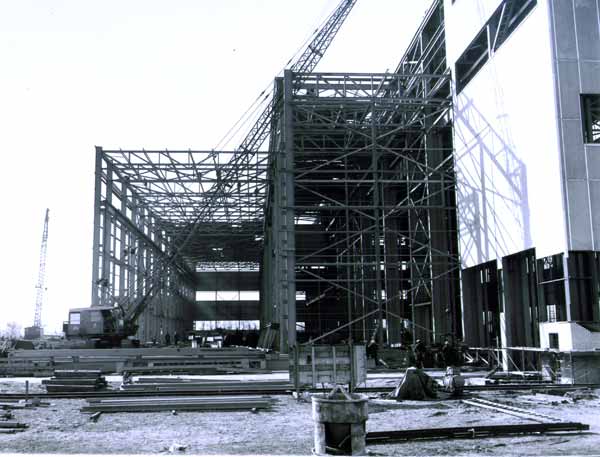
Allis-Chalmers, Transformer Assembly Building, Terre Haute
This photograph, not a postcard, has the printed text...
Allis-Chalmers
Transformer and Circuit Breaker Assembly Building
Circuit breaker and small transformer aisle on left, test apparatus aisle in center.
Construction by Austin Company, W. O. 3486, Photo #186176, 2-19-57

Allis-Chalmers, Transformer Assembly Building, Terre Haute
This photograph, not a postcard, has the printed text...
Allis-Chalmers
Transformer and Circuit Breaker Assembly Building
Large transformer assembly bay in foreground, height 92 ft., length 540 ft.
Construction by Austin Company, W. O. 3486, Photo #186177, 2-19-57
The Allis-Chalmers Manufacturing Co. of West Allis, Wisconsin was an American manufacturer with diverse interests, perhaps most famous for their bright orange farm tractors. The company eventually divested its manufacturing businesses and today is known as Allis-Chalmers Energy, and is based in Houston, Texas. As well as tractors the company also manufactured combine harvesters, hydroturbines, valves and pumps, compressors, electric motors, crushing and screening equipment, air purification and coal gasification equipment.
On April 28, 1951, the Milwaukee based Allis-Chalmers company announced that Terre Haute had been chosen as the site of a new plant to manufacture compressors for J-65 turbojet engines under the largest contract ever issued by the Curtiss - Wright Corporation. The $10 million plant was to employ between 3,500 and 4,000 people and the engines would be used in the A-4 Skyhawk, B-57 Canberra, F-11 Tiger, F-84F Thunderstreak, FJ-3 Fury, FJ-4 Fury and Lockheed XF-104 Starfighter.
Allis-Chalmers acquired a 215 acre site at 13th Street and Aythorne Avenue and the Terre Haute Chamber of Commerce planned to use the old interurban car barns at 2770 Wabash Avenue as a facility to train the engineers whilst the main plant was being built. On May 28, 1951, the plant and equipment were moved into the pilot plant / training facility.
On May 7, 1952, members of Local 1164 of the United Auto Workers went on strike. Construction of the more-than-half completed main plant stopped on June 20, 1952. Even though Allis-Chalmers threatened to pull out of Terre Haute the strike dragged on for 14 weeks. The Air Force set Tuesday, July 8, at 7:59 a.m., as the deadline for the resumption of work. Without a settlement, its mechanics would remove its machines and tools from the pilot plant. At 7 a.m. that morning, the union met in a tent adjoining the pilot plant and 250 of its 340 members voted to remain on strike. As warned, later that day air force personnel entered the building and started dismantling the equipment.
Things came to a head on Monday, July 28, 1952, which Mayor Ralph Tucker described as "a dark day in history of the City of Terre Haute." About 250 members of the Operating Engineers formed a "flying wedge" at the picket line guarding the gate at Allis-Chalmers’ pilot plant. Blocking traffic on U.S. Highway 40, the attack force broke through to allow five cars carrying 34 American Federation of Labor workers to enter the plant. The two sets of workers battled each other with fists, clubs and even knives and an American Federation of Labor worker was severely wounded with a punctured lung after being stabbed in the chest.
The strike finally was settled on August 20, 1952 and production was finally underway by December 1, but on a much smaller scale than was originally anticipated. Just 700 people of the planned 3,500 plus were employed. The air force never did return the 29 machines it had removed from the plant in July, but instead gave them to other companies to fulfill the contract. Production of J-65 turbojets was terminated by the air force in 1956 and a contract to produce J-79 assemblies was cancelled in 1957.
Allis-Chalmers, despite the problems, surprisingly still believed in Terre Haute and in 1954 announced plans to erect another $4 million plant to build transformers and switch gear in Terre Haute. There were still problems though and Terre Haute was again told that unless productivity improved the equipment would be moved back to West Allis - the home of Allis-Chalmers. Completed in 1957/8, this factory closed just four years later in 1962.
The Red Light District in 1955
During the mayorship of Vernon R. McMillan (1943 to 1948) there were apparently no brothels in Terre Haute (Index of Historical Events)(Internet Archive). How this was done since no other mayor in 50 years had managed to do it, the article doesn't say. During the 1950's, the brothels reopened but on a smaller scale, with just 10 houses and not more than 30 working girls at any one time.
The Stag article "Nighttime Girls of Terre Haute" that appeared in the November, 1955 issue is very thin on verifiable facts and written in a lurid style by Stephen Hull.. The article describes at least one bookmaker and four gambling houses that were open from 9am to midnight on Wabash Avenue. Wabash Avenue itself was described as "one of the most verminous skid rows to be found anywhere". Which I thought is odd, because that West end of Wabash Avenue could hardly ever be described as "skid row". Some of the best hotels in the city were situated here as well as many businesses. The red light district was described as being centred between Second and Mulberry Streets with the classiest brothel being run by a "Madame Rose". Street prostitutes could also be picked up along Fourth Street. Hull also described some of the sleazier bars where the prostitutes
Some of them - who couldn't be more than 20 years old, had no teeth. Did you ever see a broken-nosed, toothless female in a flour-sack dress, high on beer, try to look sexy?
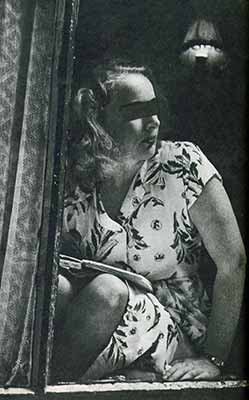
A "Window Girl"
Image from "Nighttime Girls of Terre Haute" - Stag, November 1955 edition
The magazine does state that some of the photos were not actually taken in Terre Haute, but doesn't say which ones.
The article goes on to describe what went on in the four gambling houses along Wabash Avenue where the players were charged by the hour for the use of the tables and a percentage taken from the pot. There was also a 10 dice game in several of these places. For a dime you got 5 throws of the 10 dice. If you threw 14 of ay one number then you won $5. The places also had pin-ball machines which paid out in cash - which was illegal in Indiana. One game that was common to all four places was Baseball Pool. During baseball season the scores were from the actual games, off-season and the scores were electronically generated "from a central control somewhere in Terre Haute and represent an investment of many thousands of dollars." The places were "clean and well-run; no liquor is sold in them and the play seems to be honest. They operate openly and with little attempt at concealment."
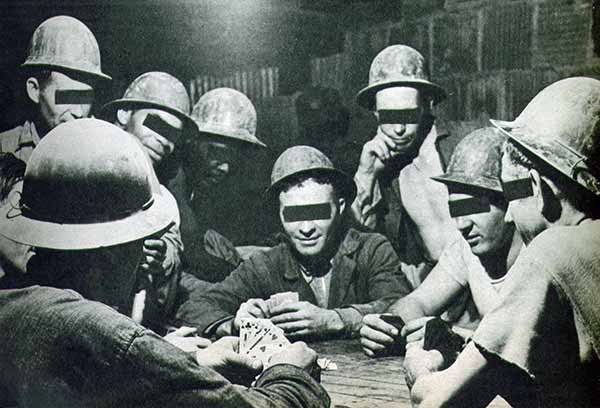
Miners Gambling
Image from "Nighttime Girls of Terre Haute" - Stag, November 1955 edition
The magazine does state that some of the photos were not actually taken in Terre Haute, but doesn't say which ones.
Drugs were not a problem in Terre Haute, but drinking was. Hull reports that the Indiana Council for Children and Youth had recently complained that they had been unable to control the sale of alcohol to teenagers. Terre Haute's then most recent semi-annual share of the revenue generated by taxes and fees by the Indiana Alcoholic Beverage Commission was $44,383.
Stag shows and sexy movies also abounded in the city. Hull reported that "Once a Sinner" and "Over-Night Girl" were films showing in one theatre. The only references to a films named "Once a Sinner" at the Internet Movie Database shows two films, one a romance made in 1931.The other film of this name was a British made B crime movie made in 1950. "Over-Night Girl" was made in 1948 and about prostitution. Two dollars would buy a ticket to one of the many burlesque shows in town.
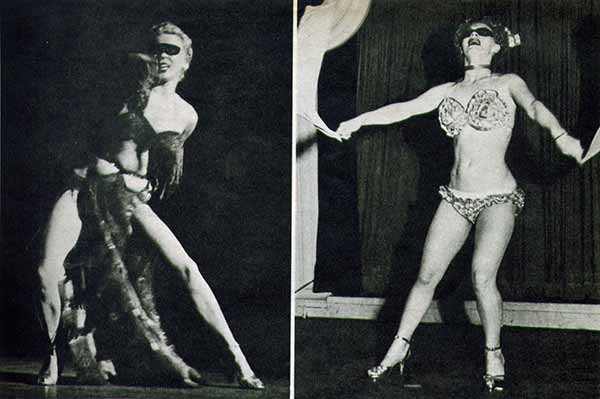
Burlesque Shows
Image from "Nighttime Girls of Terre Haute" - Stag, November 1955 edition
The magazine does state that some of the photos were not actually taken in Terre Haute, but doesn't say which ones.
Apparently people were happy with the way things were, despite earlier attempts to control the red light district. Hull interviewed a Terre Haute reporter who said...
Our police are as good as any and better than most. They could close down the line [red light district] and padlock the gambling joints, if the people wanted it done. But they don't. Even the reformers around here don't holler up reform they do in most places.